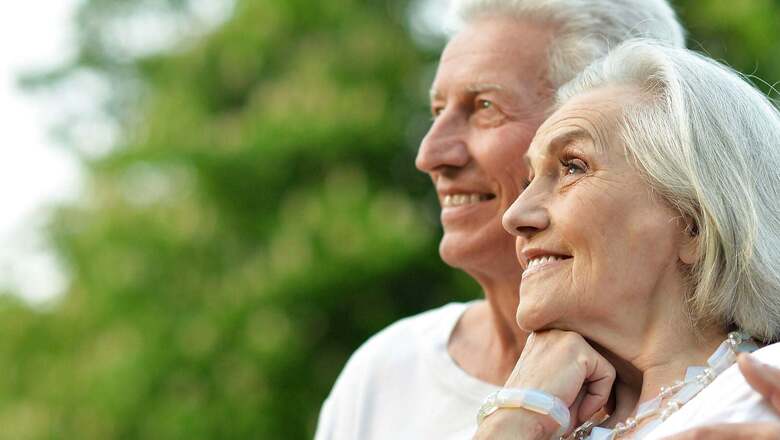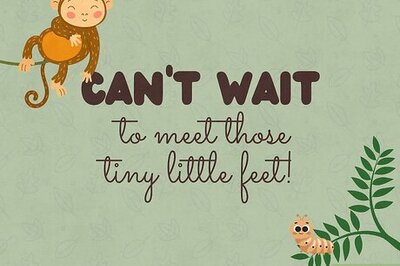
views
October 1, 2022 was globally observed as the United Nations’ (UN) International Day for Older Persons. The overarching umbrella theme for the day this year was pertinent and topical — ‘Resilience of Older Persons in a Changing World.’ Earlier this year, on June 5, 2022, the world observed ‘World Elder Abuse Awareness Day’ with another timely theme ‘Combatting Elder Abuse: What’s next?’
These two days also coincide with two important events:
First, the commencement of the United Nations Decade of Healthy Ageing (2021-2030), which marks the beginning of 10 years of concerted, catalytic, and sustained collaboration with diverse stakeholders on improving the lives of older people.
Second, 2022 marks the 20th milestone of the Second World Assembly on Ageing and the fourth review and appraisal of the implementation of the Madrid International Plan of Action on Ageing (MIPAA).
INDIA IS APATHETIC TO ITS ELDERS
Originally, I was to send this piece for the ‘International Day for Older Persons’. But I delayed it by a day to first observe silently what this day meant for India. And to my utter dismay, I discovered that in neither part of the country — ‘Bharat’ or ‘India’ – anything much happened, not even lip service on the solemn day.
Either the country lacks awareness about the day, to the declaration of which, India was a signatory (United Nations General Assembly Resolution 45/106 dated October 14, 1990) or we the people of the ‘Indian Nation’ just don’t care.
Either reason must be food for thought for India whose elderly population is increasing fast, where traditional joint family structure is breaking with accelerated urbanization, where abuse of elders is on the rise and more worryingly, where there is a spike in the annual suicides of the elderly population, as per the latest report of National Crime Records Bureau (NCRB).
THIS IS NOT MY INDIA
It’s rather strange for India, a country, which traditionally has revered elderly as the head of the family and where in Pitru Paksha, a period of 16 days as per Hindu calendar, annual Shraddha is performed for the departed souls of the family to mitigate the suffering of their souls remaining in heaven before undergoing samsara or rebirth.
India, a country which cares so much for its dead, is fast deviating from its cultural moorings of respecting and caring for its living elders.
As the average age of Indians increase, to live a long life should be a joy and to be old should not be a burden. But the contrary is happening. The worsening conditions of elderly in India reminds me of the powerful Melanie Joosten book ‘A Long Time Coming: Essays On Old Age’ that I read first in 2017, where she says starkly: “There is an invisible turning point where we stop respecting old people and begin punishing them for existing.”
HISTORY OF INTERNATIONAL DAY OF OLDER PERSONS
The structured concern for older persons/elderly first began globally with the Vienna International Plan of Action on Ageing, the first international instrument on ageing, guiding thinking and the formulation of policies and programmes on ageing. The Vienna Plan was formally endorsed by the Resolution 37/51 of the United Nations General Assembly in 1982, the same year after it was first adopted at the World Assembly on Ageing at Vienna, Austria. The Vienna Plan aimed to strengthen the capacities of governments and civil society to deal effectively with the ageing of populations and to address the developmental potential and dependency needs of older persons.
October 1 was formally designated as the International Day of Older Persons on December 14, 1990 by the United Nations General Assembly and endorsed later that year by the UN General Assembly. In 1991, the General Assembly, through its resolution 46/91, adopted the United Nations Principles for Older Persons. Also, in 2002, the Second World Assembly on Ageing adopted the Madrid International Plan of Action to respond to the opportunities and challenges of those ageing in the 21st century and to promote the development of a society for all ages.
WHY CARE FOR OLDER PERSONS?
The composition of the world population has been altering radically in recent decades. As per the United Nations data between 1950 and 2010, life expectancy worldwide rose from 46 to 68 years. Unsurprisingly, then in 2019, there were 703 million persons aged 65. The region of Eastern and South-Eastern Asia was home to the largest number of older persons (261 million), followed by Europe and Northern America (over 200 million).
And more worrying is the sober revelation that over the next three decades, the number of older persons worldwide is projected to more than double, reaching more than 1.5 billion persons in 2050. All regions will see an increase in the size of the older population between 2019 and 2050. The largest increase (312 million) is projected to occur in Eastern and South-Eastern Asia, growing from 261 million in 2019 to 573 million in 2050.
Suffice to say here that less developed countries, including India, will be home to more than two-thirds of the world’s older population (1.1 billion) in 2050.
MYTH: OLD AGE IS PROBLEM OF DEVELOPED NATIONS
Growing greying population is no longer a problem associated with developed nations of the western world. Recent Asia’s ageing population is a reflection of the unusually rapid declines in fertility and mortality rates. And the sheer numbers are mind boggling. As of 2020, the population of Asia exceeded 4.5 billion (including China and India, the two countries with over one billion each), more than half the world’s total. There were an estimated 414 million Asians aged 65 and older in 2020, projected to grow to more than 1.2 billion in 2060, which implies that one out of every 10 people in the world will be an older Asian mainly in China and India.
WHERE DOES INDIA STAND?
According to the United Nations Population Division, India’s population ages 60 and above and is projected to increase dramatically, from 8% in 2010 to 19% in 2050, when the elderly population in India will be 323 million, a number greater than the total population of the United States of America.
Also, this profound shift in the share of older Indians will be taking place in the context of changing family relationships and severely limited old-age income support. This brings in its wake varied humungous social, economic, and health care policy challenges.
A 2018 study by the Confederation of Indian Industry (CII) predicts a trebling of the population of senior citizens in India by 2050. The senior population in India is supposed to treble with longevity increasing to 75.9 years in 2050.
As per more the recent ‘NSO study Elderly in India 2021’, the elderly population in India (aged 60 and more) touched 13.8 crore (67 million males and 71 million females in 2021), growing fast due to the increase in death rate. Also, as per the study, the elderly males have outnumbered females in the past two decades, although it is projected that going further, females would outnumber elderly males in 2031.
The country’s elderly population in 2011 was 10.38 crore in 2011 which included 5.28 crore males and 5.11 crore. The study estimates that by 2031, the elderly population shall jump to 19.38 crore with 9.29 crore males and 10.09 crore females.
ELDERLY POPULATION GROWTH RATE IS VERY HIGH
During the past decade (2011-2021), the rate of growth of elderly population at 36% was thrice the rate of growth of the general population at 12%. In the coming decade (2021-2031), the differential growth rate of the elderly in India at 40.5% will be nearly five times the growth of the general population at 8.4%.
A PART OF INDIA HAS GREYED MUCH FASTER
At pan-India level, the proportion of elderly population was 8.6% in 2011, expected to be 10.1% in 2021 and projected at 13.1% in 2031.
The state-wise data of elderly population to the total state population is one of contrast.
At one end of the spectrum are states like Kerala (16.5%), followed by Tamil Nadu (13.6%), Himachal Pradesh (13.1%), Punjab (12.6%) and Andhra Pradesh (12.4%) in 2021 and by 2031 these are projected to substantially spike to Kerala (20.9%) Tamil Nadu (18.2%), Himachal Pradesh (17.1%), Andhra Pradesh (16.4%) and Punjab (16.2%).
On the contrary, in the relatively poorer states of Bihar (7.7%), Uttar Pradesh (8.1%) and Assam (8.2%), the proportion of the elderly is much lower.
Clearly one size does not fit all — India will need a state centric tailor-made solution to the problems of the elderly.
PROBLEMS FACED BY ELDERLY INDIANS
I begin by injecting a personal note — two contrasting cases from my family.
First, my father, a man of small financial means without saving or pensionary support in old age. He lived till 93 years of age and died in 2020 in the peak of Covid. He was bedridden for the past six years of his life due to a broken femur bone after a bad fall. But he lived with his full mental faculties, managed in care at home by my younger brother and his family and financially taken care of by his children. He died a happy, contented man, in the midst of children, grandchildren and great grandchildren.
My father was lucky both in life and death.
Second, my wife’s uncle aged 90 and suffering from dementia for a few years. Ever since the death of his wife, he is living in managed care at an old age home with in-house doctors and a personal assistant to take care of him at a high monthly cost. He is also living a rather happy contented life, although often in his own world. His son and daughter-in-law shuttle between USA and India, to frequently meet him and grandchildren stay connected through long-distance videoconferencing and come down from USA to meet him during vacation.
My wife’s uncle, too, is lucky.
But a majority of elderly Indians are in pitiable condition. A disproportionately large number of them belong to a category which have no money, health and social security. And those with relatively better luck are also landing in difficulties by the changing social compact, where their offspring, even if they want to, are unable to take care of them.
Old age comes with a host of problems. I try to address the more important ones below:
First, increased difficulty with everyday tasks. A person’s mobility and dexterity profoundly decline as they age, which makes completing everyday tasks increasingly difficult. This prevents older people from being social, pursuing interests, or taking part in activities they enjoyed otherwise in life.
Second, physical health and health-related problems. The ageing of India’s population is leading to fast increase in prevalence of chronic physical conditions such as diabetes, hypertension and heart ailments. It is also increasing the incidence of life-threatening illnesses such as kidney failure, strokes and cancer. One study estimates that in 2030, nearly half of India’s disease burden will be borne by older adults. Healthcare in India has already become cumbersome, complicated, and disjointed for elderly people, especially for those struggling with long-term conditions.
Third, growing old age brings a host of physical disabilities often affecting more than one activity. This problem turns more complex to manage as age advances further and most fraught cases are when one spouse dies.
Fourth, loneliness and mental illnesses have already turned into a silent epidemic. More worryingly, as per a 2022 Lancet study, the number of dementia cases in India is expected to almost double by 2050. The tally will increase to 11,422,692 from 3,843,118 in 2019, according to the analysis published in January 2022. With gross deficit of doctors with geriatric expertise, India faces a catastrophe.
Fifth, in the past two decades, India has seen an alarming increase of older Indians living with only a spouse or alone. A number of trends are responsible for these changes in living arrangements, including declining fertility leaving fewer children available to care for older parents, rural-to-urban migration for employment that separates families, and changing social expectations regarding intra-family obligations. No solution seems to be in sight.
Six, according to a study less than 11% of old Indians have a pension of any sort, although in the past few years, the government has come with some Old Age Pension scheme for poor. The amount, however, is paltry. Saving is difficult or impossible for a majority of Indians because earnings are low and out of pocket expenses for medical conditions are back-breaking.
Seventh, changing societal compact in the country has already turned disruptive, due to varied reasons including, but not limited to, industrialisation, urbanisation, technical and technological change, education, and globalisation. Already intergenerational ties have been adversely impacted with erosion of traditional Indian values
Eighth, absence of end-of-life preparations. Death is preordained is what the Indian psyche is. As a human being, every Indian needs to prepare for the inevitable, but death is often a difficult topic for people to discuss or make plans for. Worse in India, even talking about death is considered a taboo. Elderly individuals and their families need critical support for end-of-life preparations, including the options, financial implications, and how to ensure that the individual’s wishes are respected consistent with Indian societal norms, mores, and legal framework. There is a critical need to introduce this highly desirable element.
WHAT THE GOVERNMENTS ARE DOING?
Apart for lip service and crocodile’s tears, not much. The problem is humungous even today and by the end of Amrit Kaal at the time of India@100, the older population in India on a conservative basis will be more than the entire population of the United States of America.
Presently, subject matters critical to older people whether in central or state governments fall conveniently in no man’s land and the present paradigm is denial of the problem and blissful ignorance.
WHAT IS NEEDED?
To prepare for the needs of the elderly Indians by 2050, the CII, while calling from collaborating efforts, has identified nine-point solutions — independent living community, assisted living community, skilled nursing facility, continuing care retirement community, memory care facility, senior daycare facility, home care, PWD care, palliative care, and the study of ageing.
THE WAY OUT
The laundry list of the proposed solutions by the CII is copied out of a few developments in the developed countries, which although necessary is akin to playing to the gallery and protecting the interest of industry-association constituents.
Make no mistake the problem already is so monumental that no band-aid and quick fix will work. There is no easy nostrum to this national calamity. Among the many things needed urgently, I just propose three:
One, immediate setting up of the ‘National Commission to Change the Life and times of Aged’ comprising inter-disciplinary experts with fixed time frame of 12 months to give their recommendations on a comprehensive term of reference encompassing all areas.
Two, if the size of the problem population is going to exceed the entire population of USA, within six months from today, separate ministries at central and states level needs to be created with Cabinet Minister in charge so they can start implementation of the recommendations of the proposed National Commission.
Three, the central government should pass an urgent legislation in parliament to amend the Constitution of India to bring all issues related to the elderly population in one category in the Concurrent List.
Akhileshwar Sahay is a multidisciplinary thought leader with Action Bias and India-based international impact consultant. The views expressed in this article are those of the author and do not represent the stand of this publication.
Read all the Latest Opinion News and Breaking News here




















Comments
0 comment